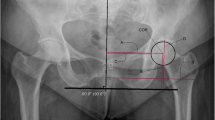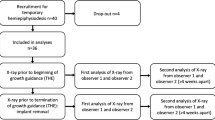Abstract
Background
The between-observer reliability of repeated anatomic assessments in pediatric orthopedics relies on the precise definition of bony landmarks for measuring angles, indexes, and lengths of joints, limbs, and spine. We have analyzed intra- and interobserver reliability with a new digital measurement system (TraumaCad Wizard™).
Methods
Five pediatric orthopedic surgeons measured 50 digital radiographs on three separate days using the TraumaCad system. There were 10 anterior–posterior (AP) pelvic views from developmental dysplasia of the hip (DDH) patients, 10 AP pelvic views from cerebral palsy (CP) patients, 10 AP standing view of the lower limb radiographs from leg length discrepancy (LLD) patients, and 10 AP and 10 lateral spine X-rays from scoliosis patients. All standing view of the lower limb radiographs were calibrated by the software to allow for accurate length measurements, using as reference a 1-inch metal ball placed at the level of the bone. Each observer performed 540 measurements (totaling 2,700). We estimated intra- and interobserver standard deviations for measurements in all categories by specialists and nonspecialists. The intraclass correlation coefficient (ICC) summarized the overall accuracy and precision of the measurement process relative to subject variation. We examined whether the relative accuracy of a measurement is adversely affected by the number of bony landmarks required for making the measurement.
Results
The overall ICC was >0.74 for 13 out of 18 measurements. Accuracy of the acetabular index for DDH was greater than for CP and relatively low for the center–edge angle in CP. Accuracy for bone length was better than for joint angulations in LLD and for the Cobb angle in AP views compared to lateral views for scoliosis. There were no clinically important biases, and most of the differences between specialists and nonspecialists were nonsignificant. The correlation between the results according to the number of bony landmarks that needed to be identified was also nonsignificant.
Conclusions
Digital measurements with the TraumaCad system are reliable in terms of intra- and interobserver variability, making it a useful method for the analysis of pathology on radiographs in pediatric orthopedics.










Similar content being viewed by others
References
Nelitz M, Guenther KP, Gunkel S, Puhl W (1999) Reliability of radiological measurements in the assessment of hip dysplasia in adults. Br J Radiol 72:331–334
Omeroğlu H, Ağuş H, Biçimoğlu A, Tümer Y (2002) Analysis of a radiographic assessment method of acetabular cover in developmental dysplasia of the hip. Arch Orthop Trauma Surg 122:334–337
Agus H, Biçimoglu A, Omeroglu H, Tümer Y (2002) How should the acetabular angle of Sharp be measured on a pelvic radiograph? J Pediatr Orthop 22:228–231
Wiig O, Terjesen T, Svenningsen S (2002) Inter-observer reliability of radiographic classifications and measurements in the assessment of Perthes’ disease. Acta Orthop 73:523–530
Schmidt GL, Altman GT, Dougherty JT, DeMeo PJ (2004) Reproducibility and reliability of the anatomic axis of the lower extremity. J Knee Surg 17:141–143
Sailer J, Scharitzer M, Peloschek P, Giurea A, Imhof H, Grampp S (2005) Quantification of axial alignment of the lower extremity on conventional and digital total leg radiographs. Eur Radiol 15:170–173
Hankemeier S, Gosling T, Richter M, Hufner T, Hochhausen C, Krettek C (2006) Computer-assisted analysis of lower limb geometry: higher intraobserver reliability compared to conventional method. Comput Aided Surg 11:81–86
Halanski MA, Noonan KJ, Hebert M, Nemeth BA, Mann DC, Leverson G (2006) Manual versus digital radiographic measurements in acetabular dysplasia. Orthopedics 29:724–726
Clohisy JC, Carlisle JC, Trousdale R, Kim YJ, Beaule PE, Morgan P, Steger-May K, Schoenecker PL, Millis M (2009) Radiographic evaluation of the hip has limited reliability. Clin Orthop Relat Res 467:666–675
Herring JH (ed) (2008) Tachdjian’s pediatric orthopaedics, 4th edn. Saunders Elsevier Inc., Philadelphia, pp 358–659, 1338
Paley D (ed) (2002) Principles of deformity correction, 1st edn. Springer, Berlin, pp 8–9
Acknowledgments
Esther Eshkol is thanked for the editorial assistance.
Author information
Authors and Affiliations
Corresponding author
About this article
Cite this article
Segev, E., Hemo, Y., Wientroub, S. et al. Intra- and interobserver reliability analysis of digital radiographic measurements for pediatric orthopedic parameters using a novel PACS integrated computer software program. J Child Orthop 4, 331–341 (2010). https://doi.org/10.1007/s11832-010-0259-5
Received:
Accepted:
Published:
Issue Date:
DOI: https://doi.org/10.1007/s11832-010-0259-5




